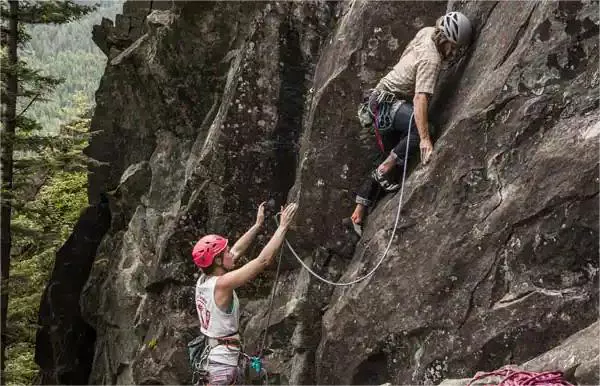In the exhilarating world of rock climbing, lead climbing stands out as a pinnacle of skill and technique. Unlike top-rope climbing where the climber is protected by a rope from above, lead climbing requires the climber to ascend with the rope trailing beneath them, clipping into protection points on the rock face as they progress. This method introduces a new level of challenge and strategy, demanding heightened awareness, efficiency, and confidence. Let’s delve into the nuances of lead climbing, exploring its techniques, equipment, and the mental fortitude required to excel in this dynamic discipline.
The Basics of Lead Climbing
Lead climbing involves a climber ascending a route from the ground up while clipping the rope into pre-placed protection points called bolts or traditional gear like cams or nuts. Unlike top-rope climbing, where the rope is already in place through an anchor at the top of the climb, lead climbing involves the climber bringing the rope up with them and attaching it to the wall as they progress.
The lead climber starts at the base of the route with the rope tied to their harness and begins climbing. As they ascend, they clip the rope into protection points using quickdraws or slings. These protection points are spaced along the route and are strategically placed to catch the climber in case of a fall. The lead climber’s belayer manages the slack in the rope, providing a dynamic belay to cushion any potential falls.
Equipment for Lead Climbing
Lead climbing requires specialized equipment beyond the basics used in top-rope climbing. Here’s a breakdown of essential gear:
- Rope: A dynamic climbing rope designed to stretch and absorb the energy of a fall.
- Harness: A comfortable harness that securely holds the climber and provides attachment points for the rope.
- Quickdraws: Sets of two carabiners connected by a short piece of webbing. Used to attach the rope to bolts or gear.
- Belay Device: A device for the belayer to manage the rope, controlling the climber’s movements and arresting falls.
- Protection Gear: Depending on the type of climbing (sport or trad), this can include bolts, cams, nuts, and slings.
- Helmet: Essential for protecting the head from falling debris.
Techniques and Skills
Mastering lead climbing demands a combination of physical strength, technical proficiency, and mental focus. Here are key techniques and skills climbers must develop:
- Clipping Technique: Efficiently clipping the rope into protection points without wasting energy or losing balance.
- Route Reading: Analyzing the climb from the ground to anticipate challenges and plan for rests.
- Fall Practice: Learning to trust the gear and belayer by practicing controlled falls.
- Managing Rope: Keeping the rope organized and avoiding tangles while climbing.
- Resting Positions: Utilizing resting stances to conserve energy on longer climbs.
- Risk Assessment: Evaluating the safety of each move and placement.
Lead Climbing Styles
Lead climbing can be further categorized into different styles based on the type of protection used:
- Sport Climbing: Climbing on pre-bolted routes with fixed protection points.
- Traditional Climbing (Trad): Placing removable protection gear like cams and nuts into cracks and fissures.
- Multi-Pitch Climbing: Ascending routes that are longer than a single rope length, requiring intermediate belay stations.
- Ice Climbing: Scaling frozen waterfalls and ice formations, using ice screws and specialized equipment.
Each style presents unique challenges and requires specific skills and equipment. Climbers often specialize in one style but may explore others to broaden their climbing experience.
Mental Aspects of Lead Climbing
Beyond physical strength and technical prowess, lead climbing tests a climber’s mental fortitude. It requires managing fear and anxiety, especially when facing exposure, difficult moves, or potential falls. Climbers must cultivate focus, resilience, and problem-solving skills to navigate challenging routes safely. Visualization techniques and controlled breathing are often employed to stay calm and composed while climbing.
Safety Considerations
Lead climbing carries inherent risks, including falls from heights. Safety protocols are essential:
- Solid Anchors: Ensuring protection points are secure and capable of withstanding a fall.
- Communication: Clear and concise communication between climber and belayer.
- Backup Systems: Using redundant systems where necessary.
- Regular Inspections: Checking gear and equipment for signs of wear and tear.
Proper training and mentorship are crucial for developing safe lead climbing practices.
Training and Progression
For aspiring lead climbers, a structured training regimen can accelerate skill development and confidence. This may include:
- Strength Training: Building upper body, core, and finger strength.
- Technique Workshops: Learning efficient movement and climbing techniques.
- Outdoor Experience: Gaining exposure to various rock types and climbing conditions.
- Mental Training: Developing focus, concentration, and overcoming fear.
- Progressive Climbing Goals: Setting achievable goals to track improvement.
Progression in lead climbing is a journey that requires dedication and perseverance. Consistent practice and learning from experienced climbers can greatly enhance one’s ability to tackle more challenging routes.
Conclusion
Lead climbing is not merely a physical activity; it’s a mental and emotional challenge that pushes climbers to their limits. It demands courage, adaptability, and a deep respect for safety protocols. As climbers conquer new heights and push boundaries, lead climbing remains a pinnacle of adventure and self-discovery in the world of vertical pursuits. Whether scaling sheer rock faces or ascending frozen waterfalls, lead climbers embody the spirit of exploration and human potential in its purest form.


